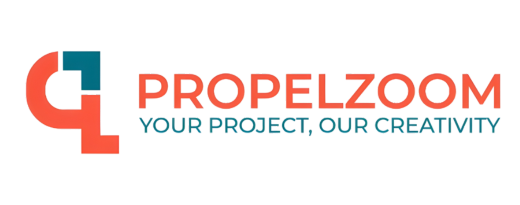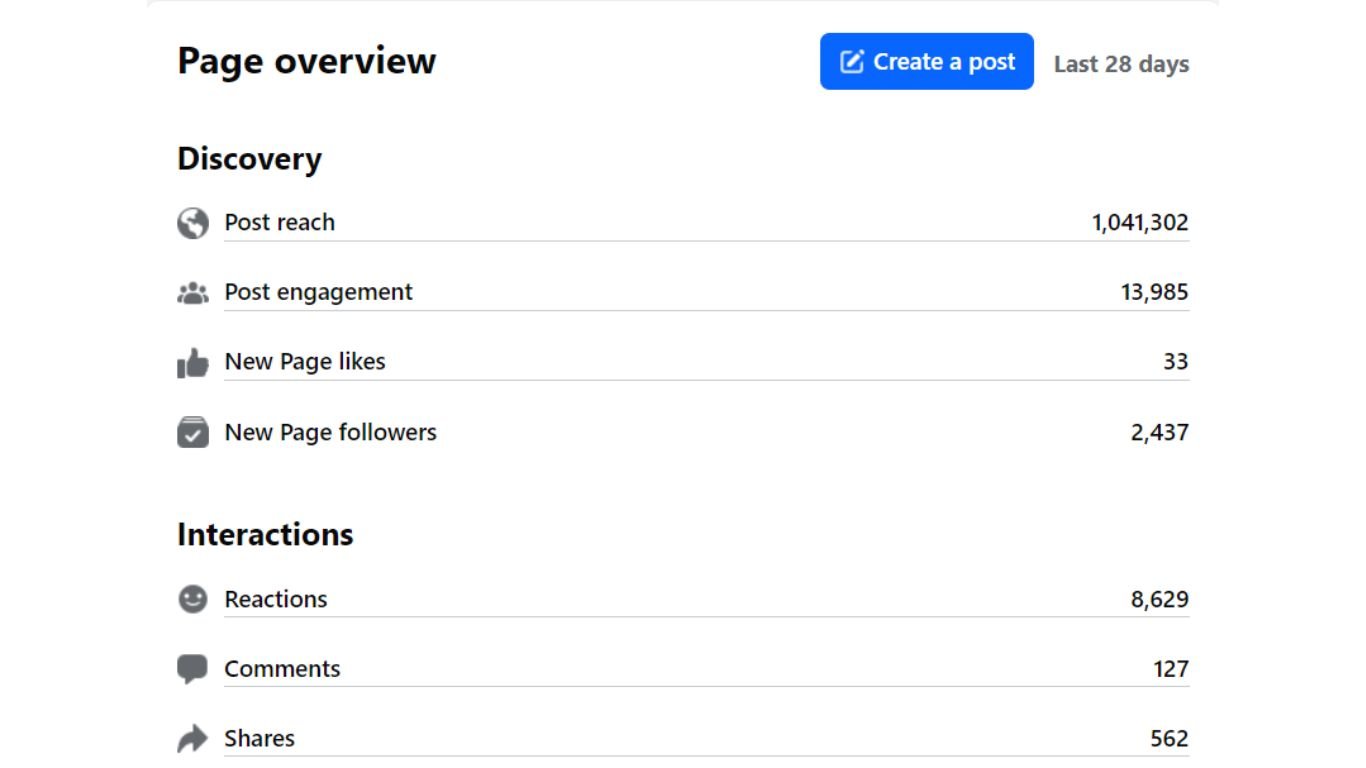At PropelZoom, we don’t just talk about results—we deliver them. Over the last 28 days, our data-driven strategies for Facebook marketing turned raw potential into real performance. From over 1 million reach to thousands of new followers, this wasn’t just a spike—it was a surge driven by precision, content, and connection.
In this case study, we’ll break down what happened in the last 28 days of a Facebook page reach, engagement, likes, followers etc, and how each metric reflects deeper business opportunities. For business owners and marketers, these numbers are more than just vanity—they’re indicators of reach, brand influence, audience interaction, and potential conversions.
Whether you’re a brand just getting started or looking to scale your presence, this insight from our own digital ecosystem at PropelZoom is your proof that smart strategy equals measurable growth.
1. Post Reach: Scaling to 1,041,302 in Just 28 Days
The number that caught everyone’s eye? A post reach of 1,041,302 in just 28 days.
What does this mean?
- Post reach refers to the number of unique users who saw any content from our page.
- This includes feed posts, stories, and shared media.
- A number over 1 million means significant visibility across Facebook’s ecosystem.
But we didn’t get here by accident. At PropelZoom, we designed every post to maximize organic discoverability. Through A/B testing, strategic post timing, and optimized visuals, we were able to consistently reach tens of thousands daily. Here’s how we made it happen:
- Optimized video content with eye-catching thumbnails.
- Scheduled posts during peak engagement windows.
- Used interest-based audience targeting for boosted content.
| Metric | Value |
| Post Reach | 1,041,302 |
| Duration | Last 28 Days |
Achieving this number shows that the last 28 days of a Facebook page reach, engagement, likes, followers etc are a powerful window into momentum. And once momentum kicks in, it’s about building trust and maintaining that visibility.
2. Post Engagement: Driving 13,985 Interactions with Smart Content
Visibility is step one. Engagement is step two—and that’s where we thrive.
In the last 28 days, we achieved 13,985 post engagements. That includes clicks, likes, comments, and shares. This level of interaction reveals audience interest and content resonance.
Let’s break down the types of engagements we focused on:
- Click-throughs from carousel posts and videos.
- Reactions that validated brand sentiment.
- Comments that sparked conversation and brand trust.
- Shares that amplified our reach organically.
This engagement didn’t just happen—it was engineered. We applied our in-house formula:
- Every post had a clear call to action.
- Captions were crafted to encourage comments and sharing.
- Our video editors created short-form content that retained attention.
Why is this important? High engagement means the Facebook algorithm will push your content further. When we studied the last 28 days of a Facebook page reach, engagement, likes, followers etc, the engagement rate directly correlated with post reach spikes. In other words, more engagement = more exposure.
This period also offered us insights into what type of content our audience loves, helping us refine future strategies.
3. Page Likes and Followers: 33 Likes vs 2,437 Followers—What It Really Means
Here’s where it gets interesting.
While we gained only 33 new Page Likes, our followers skyrocketed by 2,437. Why the difference?
Let’s decode this:
- Page Likes are users who hit “Like” on your page and are counted as fans.
- Page Followers include both those who like the page and those who only follow it.
In recent Facebook behavior trends, users are more inclined to follow pages without necessarily liking them—especially if they’re interested in updates without a full commitment.
Here’s why this matters:
- High follower count means more people are seeing our content consistently.
- It reflects ongoing interest and content subscription.
- These followers are future leads—warming up to become customers.
At PropelZoom, we treat every new follower as a long-term opportunity. We analyze their activity and design remarketing campaigns tailored to turn them into active leads.
| Metric | Value |
| New Page Likes | 33 |
| New Followers | 2,437 |
This gap also indicates a shift in user behavior on Facebook, something we’re tracking closely to adjust our growth tactics.
So, when we analyze the last 28 days of a Facebook page reach, engagement, likes, followers etc, the key lesson is this: follower growth is the fuel for sustained organic performance.
4. Interactions Breakdown: Reactions, Comments & Shares—The Pulse of a Community
When we peel back the layers of engagement, we discover what truly drives virality: emotional connections and user participation.
Over the last 28 days, our Facebook content generated:
- 8,629 reactions
- 127 comments
- 562 shares
This isn’t just social media chatter. These numbers reflect community energy, the willingness of people to engage, respond, and amplify your content. Let’s break it down:
Comments (127):
Comments indicate a higher level of user involvement. These are your potential leads—people asking questions, giving feedback, or sharing stories. We made it a practice to:
- Respond to every comment.
- Ask open-ended questions in our posts.
- Include prompts like “Tag a friend who needs this.”
This two-way communication increased our visibility and trust with the audience. Comments act as signals to the algorithm that the content is valuable.
Reactions (8,629):
Reactions are emotional signals. Whether it was a 👍 Like or a ❤️ Love, each one meant our content struck a chord. This level of reaction across the last 28 days of a Facebook page reach, engagement, likes, followers etc tells us:
- Our visuals were strong.
- Our copywriting was emotionally resonant.
- Our topics were relevant and shareable.
Shares (562):
A share is the gold standard of organic reach. It means someone found the content valuable enough to promote it to their own network. And in the last 28 days, over 500 shares fueled our reach into new circles, helping us:
- Tap into secondary audiences.
- Build viral loops.
- Boost credibility.
| Interactions | Count |
| Reactions | 8,629 |
| Comments | 127 |
| Shares | 562 |
We learned that if you want to grow fast, optimize your content for shares and comments, not just likes. Our creative team focused on posts that offered value, humor, insights, or emotional connection—fueling this incredible wave of interaction.
5. What Worked for Us in the Last 28 Days—and Why
Looking at the last 28 days of a Facebook page reach, engagement, likes, followers etc, we identified four clear success drivers:
1. Short-form Videos:
Video content with dynamic editing and storytelling saw the highest engagement. Users engaged more with content under 60 seconds that delivered immediate value.
2. Data-Backed Timing:
We posted based on our insights from Facebook Analytics. Our best-performing time slots were 12 PM–2 PM and 7 PM–9 PM, when user activity peaked.
3. Custom Design:
Using branded graphics and motion-based content helped us stand out in feeds. Our video editing service ensured a professional, polished look that made people stop scrolling.
4. Caption Strategy:
We used storytelling hooks, CTAs (call-to-actions), and question-based captions to spark interaction.
Our growth wasn’t random—it was the result of intentional strategy, team collaboration, and consistent execution.
6. The Bigger Picture: Why 28 Days of Data Matters
So why does analyzing the last 28 days of a Facebook page reach, engagement, likes, followers etc matter?
Because social media is a moving target. What worked two months ago may not work now. A 28-day window provides a recent performance pulse, and it helps answer key business questions:
- Is your content strategy working?
- Are you growing or plateauing?
- Are people engaging with your brand or ignoring it?
At PropelZoom, we use this 28-day framework as part of our monthly analytics review. It guides our decision-making and allows us to:
- Optimize ad spend
- Improve content strategy
- Retarget high-interest users
- Evaluate conversion potential from organic growth
It’s not just data—it’s a compass.
7. PropelZoom’s Process Behind the Growth
Let’s pull back the curtain. Here’s how we engineered this growth within just 28 days:
Research:
We analyzed our audience’s behaviors, top-performing competitors, and niche trends.
Strategy Development:
We crafted a monthly Facebook plan, defining:
- Post formats (videos, memes, carousels)
- Content categories (educational, inspirational, promotional)
- Hashtags and SEO-friendly descriptions
Execution:
Daily posting schedule with our creative team working on high-quality visuals, edits, and writing.
Performance Tracking:
We used Facebook Insights, Meta Business Suite, and external tools to track:
- Engagement spikes
- Follower trends
- Post performance
Each week, we adjusted our plan based on results. This agile approach allowed us to stay relevant and maximize every opportunity.
8. Lessons & What’s Next
Looking back on the last 28 days of a Facebook page reach, engagement, likes, followers etc, one thing is crystal clear: Success is replicable when you track and act.
Here’s what we learned:
- Consistency is king. Posting every day amplified momentum.
- Data-driven decisions beat guesswork.
- Visual quality matters more than ever. First impressions count.
- Audience engagement feeds future growth. Don’t ignore comments or shares.
Next month, we’re going bigger. Using our current data, we’re planning to:
- Launch targeted ad campaigns based on audience interactions.
- Boost high-performing organic content for extended reach.
- Introduce live video content to build real-time engagement.
We’ll continue to use the 28-day Facebook data cycle as our primary growth gauge—and we encourage every business to do the same.
Final Thoughts: Why You Should Care About the Last 28 Days
If you’re still not convinced, here’s the big takeaway:
The last 28 days of a Facebook page reach, engagement, likes, followers etc is not just a summary—it’s a diagnostic tool. It’s your business report card, your campaign compass, and your social proof all rolled into one.
At PropelZoom, we take data seriously—and we turn it into results.
If you’re ready to supercharge your Facebook presence, drive real engagement, and grow your brand like never before, we’re ready to help.
Let’s turn your next 28 days into your biggest success yet.


